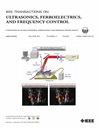利用物理引导的深度学习进行无传感器端到端自由三维超声波重构
IF 3
2区 工程技术
Q1 ACOUSTICS
IEEE transactions on ultrasonics, ferroelectrics, and frequency control
Pub Date : 2024-09-20
DOI:10.1109/TUFFC.2024.3465214
引用次数: 0
摘要
采用自由手持扫描的三维超声(3D US)成像技术可用于心脏、产科、腹部和血管检查。使用 "摇摆 "或 "矩阵 "传感器的三维 US 存在视野小和采集率低的问题,而徒手扫描因其易于使用而具有显著的优势。然而,目前采用徒手扫描的三维超声容积重建方法受到成像平面沿扫描路径移动(即平面外运动)的限制。之前的研究将运动传感器连接到传感器上,这在临床环境中既麻烦又不方便。最近的研究引入了具有三维卷积功能的深度神经网络(DNN),以便从一系列输入帧中估计成像平面的位置。然而,这些方法在估计 OOP 运动方面存在不足。本文的目标是通过设计一种新颖的、受物理学启发的 DNN 来弥合这一差距,该 DNN 适用于无运动传感器的徒手三维 US 重建,旨在提高重建质量,同时减少训练和推理所需的计算资源。为此,我们提出了基于物理引导学习的姿势信息预测模型(PLPPI),用于无三维卷积的三维徒手 US 重建。PLPPI 模型能大大提高重建的精确度,并显著减少计算时间。与最新的深度学习方法相比,它在平均百分比误差方面实现了两位数的性能提升,速度提高了106%,图形处理器(GPU)内存使用量减少了131%。本文章由计算机程序翻译,如有差异,请以英文原文为准。
Sensorless End-to-End Freehand 3-D Ultrasound Reconstruction With Physics-Guided Deep Learning
Three-dimensional ultrasound (3-D US) imaging with freehand scanning is utilized in cardiac, obstetric, abdominal, and vascular examinations. While 3-D US using either a “wobbler” or “matrix” transducer suffers from a small field of view and low acquisition rates, freehand scanning offers significant advantages due to its ease of use. However, current 3-D US volumetric reconstruction methods with freehand sweeps are limited by imaging plane shifts along the scanning path, i.e., out-of-plane (OOP) motion. Prior studies have incorporated motion sensors attached to the transducer, which is cumbersome and inconvenient in a clinical setting. Recent work has introduced deep neural networks (DNNs) with 3-D convolutions to estimate the position of imaging planes from a series of input frames. These approaches, however, fall short for estimating OOP motion. The goal of this article is to bridge the gap by designing a novel, physics-inspired DNN for freehand 3-D US reconstruction without motion sensors, aiming to improve the reconstruction quality and, at the same time, to reduce computational resources needed for training and inference. To this end, we present our physics-guided learning-based prediction of pose information (PLPPI) model for 3-D freehand US reconstruction without 3-D convolution. PLPPI yields significantly more accurate reconstructions and offers a major reduction in computation time. It attains a performance increase in the double digits in terms of mean percentage error, with up to 106% speedup and 131% reduction in graphic processing unit (GPU) memory usage, when compared to the latest deep learning methods.
求助全文
通过发布文献求助,成功后即可免费获取论文全文。
去求助
来源期刊
CiteScore
7.70
自引率
16.70%
发文量
583
审稿时长
4.5 months
期刊介绍:
IEEE Transactions on Ultrasonics, Ferroelectrics and Frequency Control includes the theory, technology, materials, and applications relating to: (1) the generation, transmission, and detection of ultrasonic waves and related phenomena; (2) medical ultrasound, including hyperthermia, bioeffects, tissue characterization and imaging; (3) ferroelectric, piezoelectric, and piezomagnetic materials, including crystals, polycrystalline solids, films, polymers, and composites; (4) frequency control, timing and time distribution, including crystal oscillators and other means of classical frequency control, and atomic, molecular and laser frequency control standards. Areas of interest range from fundamental studies to the design and/or applications of devices and systems.

 求助内容:
求助内容: 应助结果提醒方式:
应助结果提醒方式:


